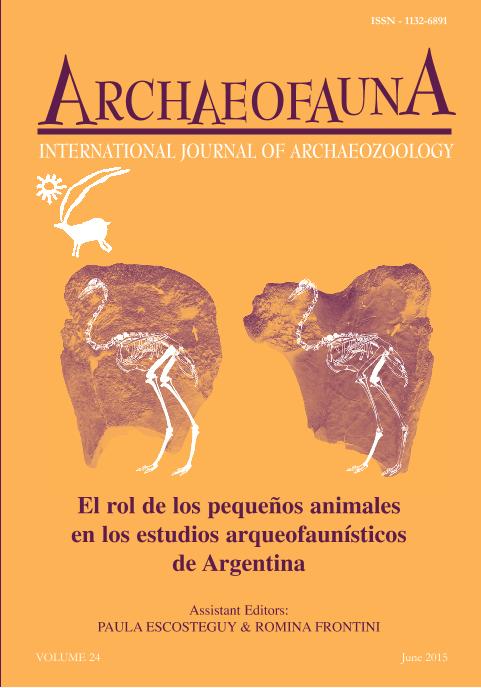Mostrar el registro sencillo del ítem
dc.contributor.author
Salemme, Monica Cira

dc.contributor.author
Tivoli, Angelica Montserrat

dc.date.available
2016-05-05T21:00:10Z
dc.date.issued
2015-06
dc.identifier.citation
Salemme, Monica Cira; Tivoli, Angelica Montserrat; Diversidad faunística en La Arcillosa 2: el aprovechamiento de aves por cazadores-recolectores del norte de Tierra del Fuego; Universidad Complutense; Archaeofauna; 24; 6-2015; 253-269
dc.identifier.issn
1132-6891
dc.identifier.uri
http://hdl.handle.net/11336/5551
dc.description.abstract
Se presentan los resultados del análisis de restos óseos de aves provenientes de La Arcillosa 2. Este sitio es un conchero multicomponente, datado entre 5500 y 3700 14C años AP, se ubica en la estepa fueguina (53º 34.450’S-68º 02.257’ O) sobre la margen derecha del río Chico (Tierra del Fuego) a 2 km al oeste de la actual costa atlántica, vinculado a lagunas interiores de características salobres, que habrían favorecido el acceso a una importante diversidad de aves. El contexto estudiado se compone de moluscos y de un conjunto de vertebrados asociados a artefactos líticos confeccionados sobre materias primas diversas. El conjunto avifaunístico aquí analizado alcanza el 25,2% del total del registro zooarqueológico. Entre los taxa de aves identificados, se destacan particularmente los anátidos, que muestran mayor intensidad de aprovechamiento que otras especies; esto se infiere a partir de las huellas de corte –recurrentes en ciertas partes esqueletales– y de los indicadores de combustión. También se registraron cormoranes, pingüinos, rapaces y passeriformes, aunque en proporciones menores.
dc.description.abstract
The analysis of bird skeletal remains from the La Arcillosa 2 site is herein presented. This multicomponent site, dated between 5500 and 3700 14C yr BP, is located in the Fuegian steppe (53° 34.450 ‘S, 68° 02,257’ W) on the right bank of the Río Chico (Tierra del Fuego), 2 km west of the present Atlantic Ocean coast. This environment, with frequent shallow and salty lagoons would have favored the access by hunter gatherers to a great diversity of bird game. The shell midden is composed of mollusk shells associated with vertebrate remains and lithic artifacts from a variety of raw materials. The analyzed avifaunal assemblage reaches 25.2% of the total sample. Among the identified taxa, the presence of waterfowl is noteworthy; the exploitation of this Family is revealed by the recurrent cutmarks in certain skeletal elements, as well as by the evidence of thermal alterations. Cormorants, penguins, raptors and passerines were also recorded, though in a lesser proportion
dc.format
application/pdf
dc.language.iso
spa
dc.publisher
Universidad Complutense
dc.rights
info:eu-repo/semantics/openAccess
dc.rights.uri
https://creativecommons.org/licenses/by-nc-sa/2.5/ar/
dc.subject
Avifauna
dc.subject
Conchero
dc.subject
Holoceno Medio
dc.subject
Estepa Fueguina
dc.subject.classification
Arqueología

dc.subject.classification
Historia y Arqueología

dc.subject.classification
HUMANIDADES

dc.title
Diversidad faunística en La Arcillosa 2: el aprovechamiento de aves por cazadores-recolectores del norte de Tierra del Fuego
dc.type
info:eu-repo/semantics/article
dc.type
info:ar-repo/semantics/artículo
dc.type
info:eu-repo/semantics/publishedVersion
dc.date.updated
2016-05-06 15:52:43.262787-03
dc.journal.volume
24
dc.journal.pagination
253-269
dc.journal.pais
España

dc.journal.ciudad
Madrid
dc.description.fil
Fil: Salemme, Monica Cira. Consejo Nacional de Investigaciones Científicas y Técnicas. Centro Austral de Investigaciones Científicas; Argentina
dc.description.fil
Fil: Tivoli, Angelica Montserrat. Consejo Nacional de Investigaciones Científicas y Técnicas. Centro Austral de Investigaciones Científicas; Argentina
dc.journal.title
Archaeofauna
dc.relation.alternativeid
info:eu-repo/semantics/altIdentifier/url/https://revistas.uam.es/archaeofauna/index
Archivos asociados
